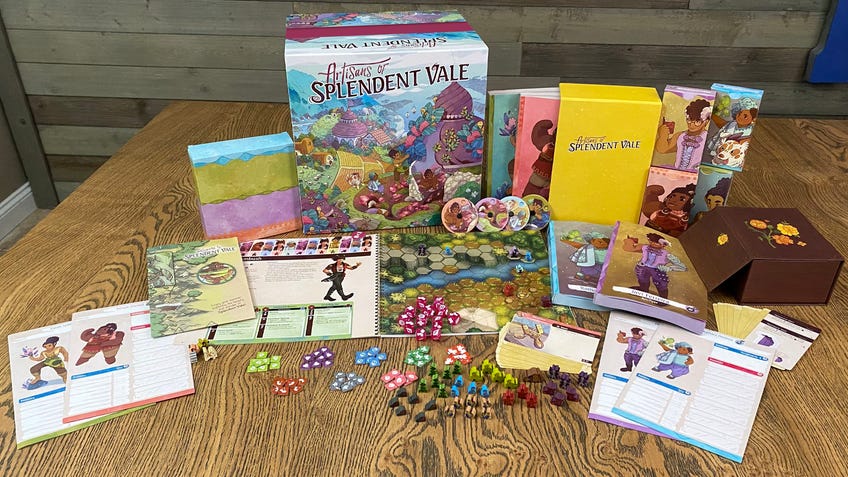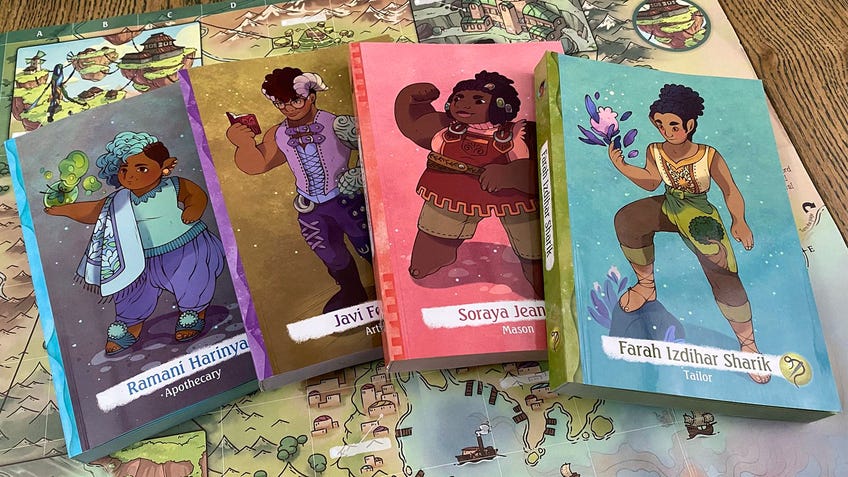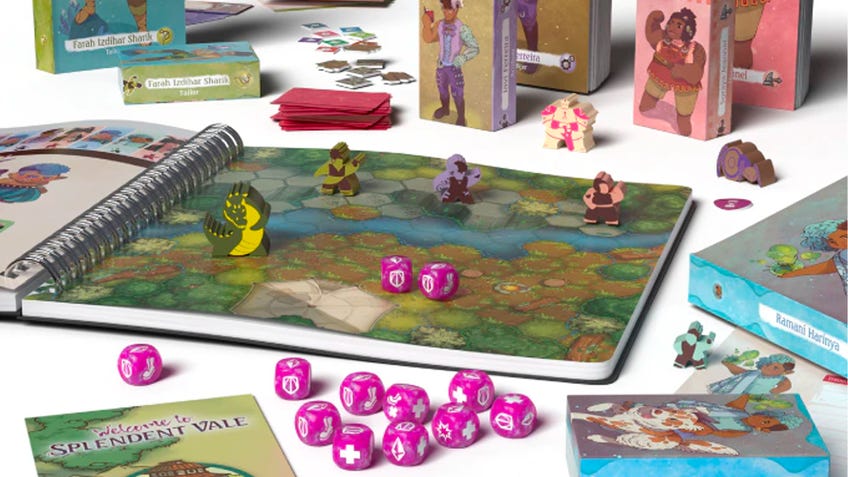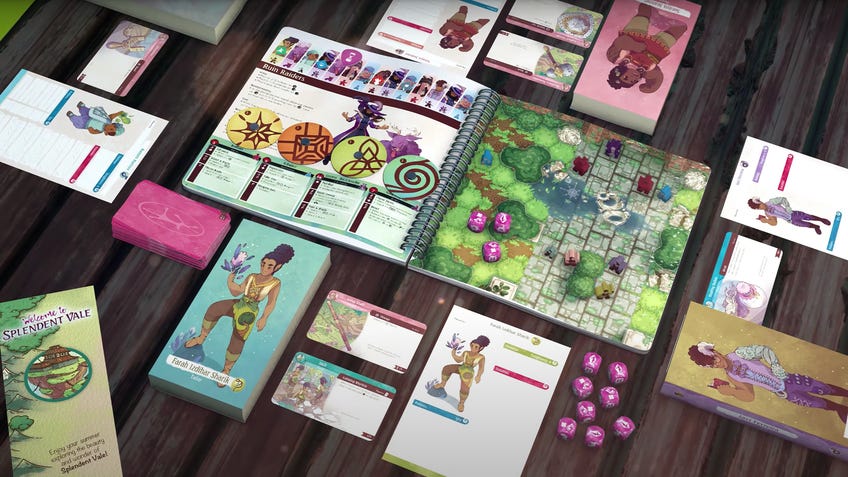‘It was important that the characters feel like real people’: Nikki Valens on representation and storytelling in Artisans of Splendent Vale
“We hope players will be able to see themselves in each of the characters in one way or another.”
Mansions of Madness and Legacy of Dragonholt designer Nikki Valens has returned with their latest ambitious story-focused board game, Artisans of Splendent Vale.
Familiar to many through their work on the Arkham Horror Files series - notably Arkham Horror’s third edition, the app-powered second edition of Mansions of Madness and Eldritch Horror - Valens moved away from cosmic horror with 2017’s Legacy of Dragonholt, which saw them delve further into storytelling with a RPG-inspired narrative game set in the fantasy world of Terrinoth.
Departing Fantasy Flight Games in early 2018 - after more than five years at the publisher - Valens went on to create charming robot-programming co-op board game Quirky Circuits, which tasked players with overcoming the chaos of group communication to clean various rooms in a number of distinct scenarios.
Valens’ next project is Artisans of Splendent Vale, a return to the collaborative narrative focus of their previous games. Set in an idealistic fantasy land, Artisans sees players step into the soil, paint and fur-flecked boots of a party of crafters who must work together and use their unique skills to explore the world. The party includes a number of QTPOC and disabled characters, written and illustrated in collaboration with consultants.
Artisans of Splendent Vale is billed as offering a campaign estimated to last for over 50 years, broken into a number of separate adventures, that combines elements of choose-your-own-adventure stories, pen-and-paper roleplaying games and legacy board games in its open-world, player-driven story.
With Artisans of the Splendent Vale currently live on Kickstarter ahead of its planned release by Renegade Game Studios next summer, I spoke to Valens about their approach to storytelling, capturing the game’s evolving world and the importance of allowing players to see themselves in the inhabitants of Splendent Vale.

Artisans is your latest story-driven game, following the likes of Legacy of Dragonholt and the Arkham Horror Files series. How does the game’s narrative elements compare to your previous narrative designs?
Artisans of Splendent Vale has a lot in common with both Legacy of Dragonholt and Mansions of Madness, with even a touch of Eldritch Horror's storytelling for good measure. The core of the game's story is told through its books similar to Dragonholt, but while Dragonholt has a single narrator and a single storybook, Artisans' story is told via four unique character-specific books. Each player has their own character and their own book from which they read, telling the story as a group and bringing their own character's abilities, backstory and personality into each scene. In the moment, it's akin to a roleplaying game or doing a stage reading with your friends.
In the moment, it's akin to a roleplaying game or doing a stage reading with your friends.
Artisans also has tactical action scenes where timing, movement and teamwork are important factors. While Mansions of Madness is a constant time crunch as players work to uncover a mystery as quickly as possible, Artisans of Splendent Vale instead chooses to ask players to maintain the heavier rules of an action scene only in moments of tension and drama within the greater story. Exploration and dialogue will happen in the story books, while all of the action, tension and danger occurs within action scenes.
And last (but certainly not least), between their adventures, the characters have time to themselves to rest, craft and spend time with their families and friends. These interludes are a peek into the personal lives of the characters as well as the city they all live in, told in the form of short vignettes.

Could you please give us a brief idea of how Artisans plays - particularly its legacy-like aspects? How does this contribute to the players’ experience of the game, its world and story?
While not a legacy game in the truest sense of the word, Artisans of Splendent Vale uses legacy components to help generate story and streamline the process of story progression and character advancement. When unlocking or upgrading character abilities, stickers are used to keep all of a player's character specific options neatly contained on their character sheet. Likewise, as the players upgrade their equipment and personal skills, stickers are used to permanently modify cards in precisely the ways the players have chosen, keeping their options easily visible during action scenes.
Story and player progression are similarly tracked by recording notes and modifying the adventure log, world map and character sheets directly. Overall, it creates a sense of a world ever-changing and a group of characters ever-growing as time passes.

Artisans is sadly distinct in board games for featuring multiple playable QTPOC characters, as well as disabled characters. Could you tell us about creating these characters for players to embody, and how they reflect the story and world of the game?
I wanted to show characters from many different cultures and identities living together and cooperating without prejudice or bias. A perhaps-idealistic view of what I hope we can one day achieve in real life.
The game takes place in the Splendent Vale, a region where collaboration and camaraderie are valued above all else. Thanks to the lush and bountiful nature of the Vale, the people living there have their basic needs easily met and they are thus allowed complete freedom to follow their passions, hone their crafts, and find their own ways of giving back to their community.
To reflect this near-utopian society, I wanted to show characters from many different cultures and identities living together and cooperating without prejudice or bias. A perhaps-idealistic view of what I hope we can one day achieve in real life.
It was important to me (and important to many players) that these characters feel like real people with enough depth to become loved by the players. The best and easiest way to do so is to create from lived experiences, which is why I reached out to cultural consultants to not only help me create these characters and their backstories, but also help shape the world they live in and the story told by the game. Much like the world we made, the creation process was a collaborative effort, made richer by our personal experiences as well as our shared experiences.
We hope players will be able to see themselves in each of the characters in one way or another.


